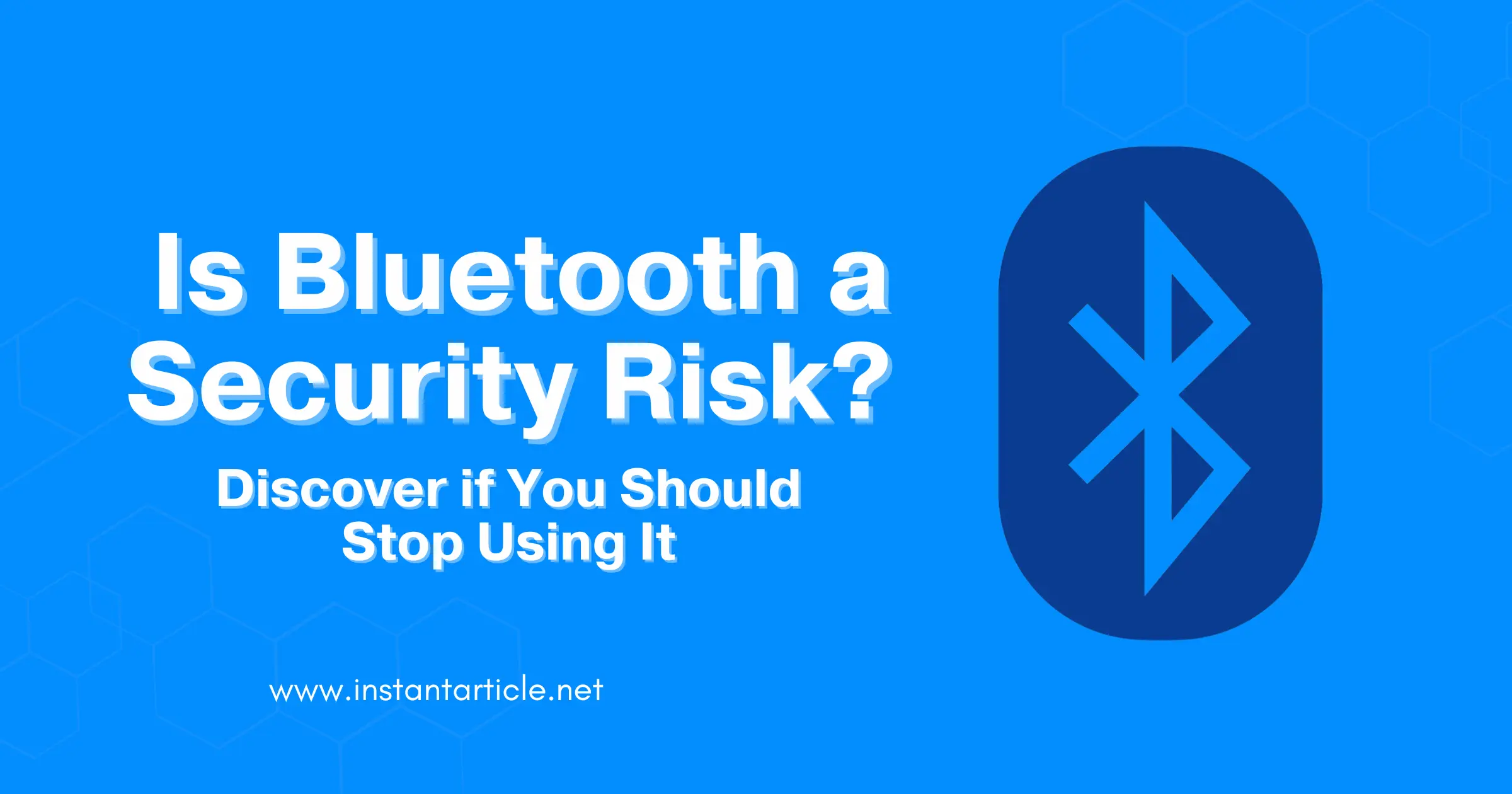Bluetooth has revolutionized how we connect our devices, offering seamless wireless communication and making our lives more convenient. From connecting wireless headphones to controlling smart home devices, Bluetooth is a staple in modern technology. However, as with all technology, there are potential risks involved. Is Bluetooth a security risk? This question is crucial as we navigate an era of increasing cyber threats. Let’s explore the potential risks and learn how to protect our data effectively.
What is Bluetooth Security Risk?
Bluetooth is a wireless technology standard used for exchanging data between fixed and mobile devices over short distances. It’s widely adopted for its convenience, allowing users to connect devices like smartphones, laptops, speakers, and more. However, the simplicity and openness of Bluetooth can also present certain security challenges.
Security Risks of Bluetooth:
- Unauthorized Access: Hackers can exploit Bluetooth connections to gain unauthorized access to devices and data.
- Data Interception: Bluetooth signals can be intercepted, allowing hackers to access sensitive information during transmission.
- Device Hijacking: Cybercriminals can hijack Bluetooth devices, using them to launch attacks on other systems or devices.
- Denial of Service Attacks: Attackers can flood a Bluetooth connection with requests, disrupting its functionality.
- Malware Distribution: Bluetooth can be used as a vector for spreading malware between connected devices.
These security risks can be concerning, especially when Bluetooth is used for transmitting sensitive data or controlling critical systems.
Let me share a personal experience that highlights the real-world implications of these security risks. A few years ago, while using a Bluetooth-enabled headset at a local café, I noticed something strange. My phone suddenly started playing a song I hadn’t selected. After some investigation, I realized that another person in the café had unknowingly connected to my headset. Fortunately, it was a harmless incident, but it opened my eyes to how easily Bluetooth connections can be accessed without the proper security measures.
Common Bluetooth Vulnerabilities
Understanding the specific vulnerabilities associated with Bluetooth can help you take appropriate precautions. Some of the most common vulnerabilities include:
BlueBorne Attack
BlueBorne is a type of Bluetooth-based attack discovered in 2017. It allows hackers to take control of devices, access sensitive data, and spread malware. The attack exploits vulnerabilities in the Bluetooth protocol, affecting billions of devices worldwide.
Case Study: According to a study by Armis Labs, the BlueBorne attack was found to potentially impact over 5 billion devices globally. The study highlighted the ease with which hackers could exploit these vulnerabilities, demonstrating the urgent need for improved security measures.
Bluesnarfing
Bluesnarfing involves unauthorized access to a device’s information through a Bluetooth connection. Hackers can use specialized software to intercept data such as contact lists, messages, and photos without the device owner’s knowledge.
Bluejacking
Bluejacking is the practice of sending unsolicited messages to Bluetooth-enabled devices. Although it’s more of an annoyance than a serious threat, it can be used to distribute malicious links or phishing messages.
Bluebugging
Bluebugging is a more severe attack that allows hackers to take control of a device and listen to phone calls, read messages, or even make calls without the user’s permission.
How Hackers Exploit Bluetooth
Hackers use various techniques to exploit Bluetooth connections and gain access to sensitive data. Here’s how they do it:
- Scanning for Devices: Hackers use specialized tools to scan for nearby Bluetooth-enabled devices that are in discoverable mode.
- Brute Force Attacks: Attackers use brute force methods to crack Bluetooth pairing codes and gain unauthorized access to devices.
- Exploiting Weaknesses in Protocols: Cybercriminals exploit vulnerabilities in Bluetooth protocols to execute attacks like BlueBorne.
The ease with which hackers can exploit Bluetooth vulnerabilities highlights the importance of taking security measures seriously.
How to Protect Yourself from Bluetooth Security Risks
While Bluetooth poses certain security risks, there are steps you can take to minimize these threats and protect your data. Here are some essential tips for safeguarding your Bluetooth devices:
1. Keep Devices Updated
Regularly updating your devices ensures that you have the latest security patches and bug fixes. Manufacturers often release updates to address known vulnerabilities, so keeping your devices current is a critical step in protecting against Bluetooth security risks.
Example: Apple and Google frequently release updates for iOS and Android that include security patches for Bluetooth vulnerabilities. Staying up-to-date with these updates can significantly reduce the risk of attacks.
2. Disable Discoverable Mode
When your device is in discoverable mode, it broadcasts its presence to other Bluetooth-enabled devices, making it easier for hackers to find and exploit. Disable discoverable mode when not pairing devices to reduce the risk of unauthorized access.
3. Use Strong Pairing Codes
When pairing Bluetooth devices, use strong, unique pairing codes to enhance security. Avoid using default or easily guessable codes, as these can be easily cracked by attackers.
4. Turn Off Bluetooth When Not in Use
Leaving Bluetooth enabled when it’s not in use increases the risk of unauthorized access. Turn off Bluetooth when you’re not using it to minimize the attack surface and reduce potential vulnerabilities.
5. Monitor Paired Devices
Regularly check the list of paired devices on your Bluetooth-enabled devices. Remove any unfamiliar or unused devices to prevent unauthorized access and maintain control over your connections.
6. Use Security Apps
Consider using security apps or software that offer Bluetooth protection features. These tools can help monitor and detect suspicious activity, providing an additional layer of security against Bluetooth attacks.
Bluetooth Security in Different Industries
Bluetooth technology is used across various industries, each facing unique security challenges. Here’s a look at how different sectors manage Bluetooth security risks:
Healthcare
In healthcare, Bluetooth is used for medical devices, patient monitoring systems, and more. The security of these connections is critical to protect sensitive patient data and ensure the proper functioning of medical equipment.
Real-Life Scenario: Imagine a hospital using Bluetooth-enabled insulin pumps. If a hacker were to exploit a vulnerability, they could potentially alter the pump’s settings, posing a significant health risk to patients. This scenario underscores the need for stringent security protocols in the healthcare industry.
Automotive
Bluetooth technology enables hands-free calling, audio streaming, and connectivity features in modern vehicles. Security measures are essential to prevent unauthorized access to vehicle systems and ensure driver safety.
Smart Home Devices
Smart home devices, such as smart speakers and thermostats, often use Bluetooth for connectivity. Implementing robust security protocols is crucial to prevent unauthorized access and protect personal data.
Wearable Technology
Wearable devices, like fitness trackers and smartwatches, use Bluetooth to sync data with smartphones. Ensuring the security of these connections is vital to protect user privacy and prevent data breaches.
Should You Stop Using Bluetooth?
While Bluetooth security risks are real, stopping its use altogether may not be necessary. Instead, adopting best practices and implementing security measures can help mitigate these risks and allow you to continue enjoying the benefits of Bluetooth technology.
By being aware of potential threats and taking proactive steps to protect your devices, you can reduce the likelihood of falling victim to Bluetooth-related attacks. As technology continues to evolve, staying informed and vigilant is essential to maintaining your digital security.
Engaging with the Reader
Now that you understand the potential security risks associated with Bluetooth, take a moment to reflect on your own device usage. Are there any steps you can take today to enhance your security? Perhaps it’s time to review your device settings or install a security app. Remember, staying proactive is the key to safeguarding your data in an increasingly connected world.
Frequently Asked Questions (FAQs)
Bluetooth can be safe if proper security measures are implemented. Keeping devices updated, using strong pairing codes, and disabling discoverable mode can enhance Bluetooth security.
Yes, hackers can exploit vulnerabilities in Bluetooth to access devices. However, by following best practices and security tips, you can minimize this risk.
BlueBorne is a type of Bluetooth-based attack that allows hackers to take control of devices, access sensitive data, and spread malware. It exploits vulnerabilities in the Bluetooth protocol.
Protect your Bluetooth devices by keeping them updated, using strong pairing codes, disabling discoverable mode, and monitoring paired devices.
You don’t necessarily need to stop using Bluetooth. By implementing security measures and being aware of potential risks, you can continue to use Bluetooth safely.
Industries such as healthcare, automotive, smart home, and wearable technology are affected by Bluetooth security risks. Each sector faces unique challenges in securing Bluetooth connections.
Conclusion
Bluetooth technology offers remarkable convenience, but it also comes with security risks that users must address. By understanding these risks and taking appropriate precautions, you can protect your devices and data while enjoying the benefits of wireless connectivity. Staying informed and vigilant is key to navigating the ever-changing landscape of digital security.

